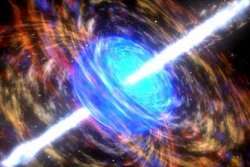A Violent History of Time

From mother Earth, the night sky can look peaceful and unchanging, but the universe as seen in gamma-rays is a place of sudden and chaotic violence. Using gamma-ray telescopes, astronomers witness short but tremendously intense explosions called gamma-ray bursts, and there is nothing more powerful.
No one is sure what causes gamma-ray bursts. Favored possibilities include the collision of two neutron stars or a sort of super-supernova that occurs when extremely massive stars explode. One thing is certain: gamma-ray bursts happen in galaxies far, far away -- so far away that the distances are called "cosmological," beyond ordinary comprehension.
Think about this: When you look up at the night sky, you are looking at the ultimate history book – one that goes back to the very beginning of what we call time. And each star is a chapter in the book. You are not really seeing the stars as they are now. You are looking at stars as they used to be when their light left them long ago. And the deeper we peer into space, the farther back in time we are looking. In fact, light from the galaxies farthest away is billions of years old.
"Gamma-ray bursts are so bright we can see them from billions of light years away, which means they occurred billions of years ago, and we see them as they looked then," says Charles Meegan of NASA's Marshall Space Flight Center. "They can help us look back in time and teach us something about the conditions in the early universe. In gamma-ray bursts, we may be seeing the first generation of stars, from the earliest galaxies created after the Big Bang."
Not only do gamma-ray bursts help scientists learn about our universe's history; they also help explain its physics. But the tricky part in studying a gamma-ray burst is catching it before it disappears. Each burst happens and fades so fast that it's hard to detect them all. It's like trying to capture every single firefly's flash on a summer night with an ordinary camera.
NASA's Gamma-Ray Large Area Space Telescope, GLAST for short, will soon help in the chase. More on that in a minute, but first, let us set the stage with a little history.
Scientists have been hot on the gamma-ray trail for years, but the bursts were actually discovered by accident. During the Cold War in the 1960s, US satellites keeping an eye out for Soviet nuclear testing in violation of the Limited Test Ban Treaty detected intense bursts of gamma radiation. But the bursts weren't coming from the Soviet Union. Scientists realized that the bursts were coming from space!
Quickly, gamma-rays bursts became one of the most compelling mysteries of astronomy, and NASA decided to build a Great Observatory to map the gamma-ray sky. In the 1990s, the Compton Gamma-ray Observatory discovered more than 400 new gamma-ray sources and recorded 2704 gamma-ray bursts, detailing the gamma-ray universe early satellites had merely glimpsed. Most importantly, Compton uncovered evidence that gamma-ray bursts issued not from the Milky Way, but from staggeringly distant galaxies.
To be seen at such distances, the explosions had to be almost impossibly violent, astronomers realized. In a way, this was no surprise. Gamma rays are by their very nature a herald of great energy and violence. Consider the following: gamma rays are a super-energetic form of light. Ordinary visible photons, the kind we see with the human eye, have energies of about 2 to 3 electron-volts. Gamma-ray photons have energies greater than 10 giga-electron-volts (GeV), billions of times that of ordinary light. Ground-based observatories have detected gamma-rays of even higher energy – thousands of GeV.
In May 2008, NASA will launch GLAST to welcome these high-energy messengers. GLAST's main instrument, the Large Area Telescope (LAT), will make pioneering observations of gamma-ray bursts at higher energies than ever before from space. It is expected to accurately locate 50 or so bursts per year. Meanwhile, another instrument onboard GLAST, the GLAST Burst Monitor (GBM), will monitor gamma-ray bursts at lower energies.
By working together, these two instruments will capture the whole energy range of these cosmic fireflies – from 10 thousand eV to 100 giga-electron-volts.
"Capturing the events in more than one wavelength will help scientists understand more about them, kind of like seeing in color instead of black and white," says Meegan. "We can't reproduce in any laboratory the extreme physical conditions that occur in gamma-ray bursts, so we don't understand how they work. By studying them with these instruments, we may learn some new physics about matter."
"I think it is likely that LAT and GBM will see something new and unpredicted from gamma-ray bursts. They will likely answer some old questions and raise new ones."
That's what science always seems to do. Stand by for launch in May 2008!
Source: Science@NASA, by Dauna Coulter





















